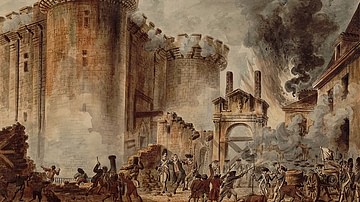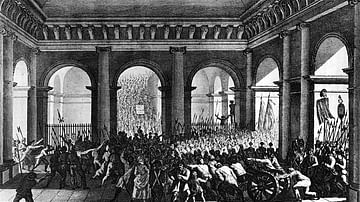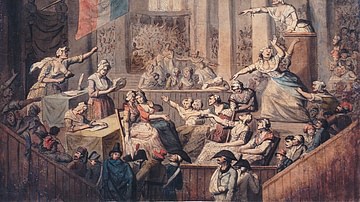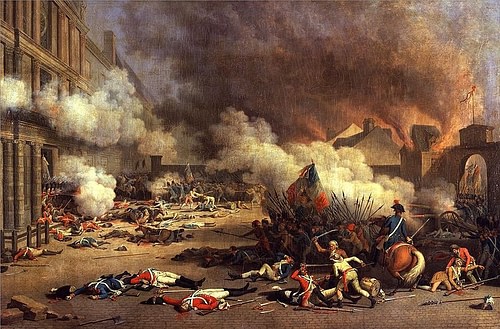
The Storming of the Tuileries Palace, also commonly known as the Insurrection of 10 August, was a defining moment in the French Revolution (1789-99) that saw the armed revolutionaries of Paris invade the residence of King Louis XVI of France (r. 1774-1792) and massacre his Swiss Guards. The event effectively abolished France's monarchy, ushering in a new phase in the Revolution.
Prior to the insurrection, an uneasy reconciliation had been made between Louis XVI and the revolutionary government. Yet the first weeks of the French Revolutionary Wars (1792-1802) resulted in French defeat, and many blamed the king. His vetoes on popular rulings by the Legislative Assembly led to the Demonstration of 20 June 1792, when revolutionaries first stormed the Tuileries; this failed to fix the underlying problems, leading to a second, bloody insurrection on 10 August that resulted in the suspension of the monarchy and catapulted France toward republicanism.
Aside from abolishing monarchy, the Storming of the Tuileries is significant for putting more power into the hands of the sans-culottes, the working-class revolutionaries. The struggle between the Revolution's bourgeois leaders and the sans-culottes would carry on into the Revolution's darkest days.
Demonstration of 20 June
The beginning of the end of both Louis XVI's ill-fated reign and his unhappy life can be traced back to 20 April 1792, when France declared war on Austria, sparking the War of the First Coalition (1792-97). According to propaganda by the hawkish Girondin faction in the Legislative Assembly, it should have been an easy war, with French citizen-soldiers sweeping into Belgium and Germany to deliver the bounties of the French Revolution at the point of the bayonet.
In reality, the French revolutionary army was hardly up to the task; undersupplied, undisciplined, and divided, the French had crumbled before the professional armies of Austria within days of the declaration of war. Having already lost between a third and one-half of its experienced officers to anti-revolutionary emigration, the French military suffered further when entire regiments began defecting to the Austrian side.
In Paris, the Legislative Assembly attempted to curtail France's failing fortunes with a series of decrees aimed at fortifying the city from the nation's enemies. The first was a decree ordering the deportation of all refractory priests, who had refused to swear the oath of loyalty to the state as required by the Civil Constitution of the Clergy. The second was to disband the king's 6,000-man Constitutional Guard, which had been formed the previous September for his protection. The third was to assemble 20,000 fédérés, militiamen from the provinces, in Paris, ostensibly to protect the capital from Austrian attack. While the king consented to the disbanding of his Constitutional Guards, he used his veto on the other two decrees. When his Girondin-dominated ministry chastised him for this, he cleaned house and replaced them with loyal Feuillants (constitutional monarchists).
The king's stubbornness earned him the ire of the Assembly, the Girondins, and the people, who believed that his actions were contrary to the defense of France. Indeed, rumors stirred up by inflammatory journalists like Jean-Paul Marat held that the royal court was the center of an “Austrian Committee”, which meant to sabotage the war effort and deliver Paris to the Austrians. Although not entirely accurate, this theory was closer to the mark than many would have liked to believe, as French Queen Marie Antoinette (1755-1793) was indeed sending military secrets to her contacts in Austria, gambling that the Austrians would restore her husband to his full powers in the event of a French defeat.
These factors culminated in the Demonstration of 20 June 1792, when thousands of Paris’ working class, calling themselves sans-culottes (literally, "without silk breeches") invaded the Tuileries Palace armed with pikes. They found the king accompanied only by a handful of guards and attendants and proceeded to threaten and belittle him. They may have resorted to violence if the king had put up any sort of resistance. Instead, he greeted them warmly, conversing with them and drinking toasts to the people and the nation. He even wore a red cap of liberty that was presented to him.
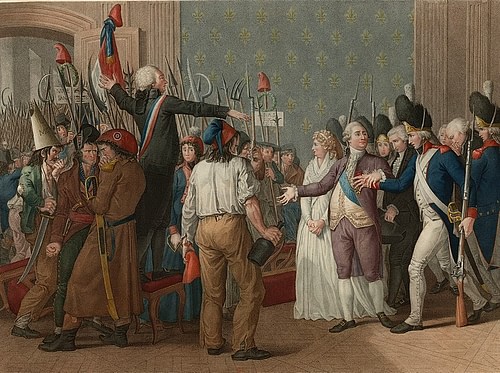
Throughout all this, Louis XVI uncharacteristically stood his ground, refusing to back down on his previous decisions. After planting a liberty tree on the palace grounds, the crowd melted away, leaving Louis and Marie Antoinette to breathe sighs of relief. Yet, the events of 20 June had changed nothing, except to further desecrate the perception of majestic awe that had once been synonymous with the French monarchy.
Fatherland in Danger
As tensions brewed in Paris, the situation on the war front grew bleaker. In June, Prussia entered the war on Austria's side, and the two nations began marshalling an army under the command of the Duke of Brunswick to invade France and topple the revolutionary regime. The Austro-Prussian force would be reinforced by an army of anti-revolutionary French émigrés, who mainly consisted of aristocrats and military officers who had fled the Revolution. On 5 July, the French Legislative Assembly responded to this threat by proclaiming a state of emergency, announcing that "la patrie est en danger" ("the fatherland is in danger").
Citing this emergency, the Assembly circumvented the king's vetoes and ordered 20,000 provincial militiamen, the fédérés, to come to Paris. Over the coming weeks, armed men came streaming into the capital from across the country. On 30 July, a group of 500 men from Marseille entered the capital, singing a new patriotic anthem that would afterwards be named for them, La Marseillaise. In the meantime, the Assembly raised new battalions of the National Guard, filling their ranks with 15,000 Parisian volunteers. The presence of all these rowdy, armed men did little to calm anxieties, especially once fédérés and National Guardsmen began brawling openly in the streets.
Hoping to maintain support for the war, the Assembly also ordered the governments of each of Paris' 48 sections to remain in permanent session, and for every official institution to hold their meetings in public. Quickly, discussions in these session assemblies turned to the establishment of a republic; the public nature of these meetings meant that dissenters were shouted down by crowds of onlooking sans-culottes. The fédérés, who not only attended these meetings but lodged with militant patriots or on the grounds of the republican Cordeliers Club, were especially taken by this atmosphere of revolutionary fervor. These ideas resonated with many of them, particularly those from regions where revolutionary gains were more contested.
Talks in these session assemblies were fueled by the provocative rhetoric of journalists like Marat, who appealed to the poor in his newspaper L'Ami du Peuple and attacked the Revolution's bourgeois leaders, asking why "the rich alone should harvest the fruits of the revolution" (Schama, 611). Pierre Vergniaud, a prominent Girondin, gave a speech on the floor of the Legislative Assembly, accusing the king of working with the enemy and effectively calling for his abdication. On 31 July, Mauconseil, one of Paris' sections, published an address which echoed both sentiments, and demanded that the people take the Revolution back into their own hands:
The most sacred duty…is to forget the law to save the patrie. For too long, a despicable tyrant has played with our destinies…without amusing ourselves any longer by calculating his errors, his crimes, and his perjuries, let us strike this colossus of despotism…let us all unite to declare the fall of this cruel king, let us say with one accord that Louis XVI is no longer king of the French (Schama, 612).
This was a significant development, as much of the city and its leadership was now calling for the overthrow of the king. The mounting fear and anger would only worsen when news reached Paris of the Brunswick Manifesto.
Brunswick Manifesto
The Duke of Brunswick, commander of the invading Austro-Prussian army, did not write the manifesto that bore his name. Rather, it was written by leading French émigrés. This is made apparent when reading the fiery words of the document, exemplifying the hatred the émigrés bore for the revolutionary regime which had supplanted them.
In essence, the manifesto condemned the recent actions of France, including its declaration of an "unjust war" on Austria as well as its treatment of Louis XVI and his family, who had been subjected to "outrage and brutalities which continue to be renewed daily." It announced the invading army's intentions to put an end to the anarchy plaguing France and to restore Louis XVI to his powers. It asked the "sane portion of the French nation" to rise up against the "odious enterprises of their oppressors." Any Frenchman who resisted was to be considered a rebel and subjected to the "most stringent laws of war" (Brunswick Manifesto).
But it was against the city of Paris itself that the manifesto issued its clearest and most menacing threat:
The city of Paris and all its inhabitants without distinction shall be required to submit at once and without delay to the king…[the sovereigns of Austria and Prussia] declare, on their word of honor as emperor and king, that if the chateau of the Tuileries is entered by force or attacked, if the least violence be offered to their Majesties the king, queen, and royal family, and if their safety and their liberty be not immediately assured, they will inflict an ever memorable vengeance by delivering over the city of Paris to military execution and complete destruction, and the rebels guilty of the said outrages to the punishment that they merit. . . . (cited from the Hannover Historical Project)
The Brunswick Manifesto, issued on 25 July, was intended to ensure the safety of Louis XVI and his family by intimidating Paris into submission. Of course, it would have the opposite effect. When word reached Paris on 1 August, it banded the horrified and enraged citizens together against the invaders. Threatened with the total destruction of their city, and their own executions as rebels, the Parisians' resolve to defend their home was only strengthened.
Insurrection
In the days following the release of the manifesto, Paris bustled with activity. Under the direction of the powerful political club, the Jacobins, coordinating committees were set up in the 48 sections, to prepare the fédérés for action. Patriotic National Guardsmen deserted their posts and joined up with the sections. The sans-culottes were also mobilized by their own leading figures including Fournier 'the American', and the brewer Antoine Santerre. Clearly, a massive demonstration was being mobilized, one that would strike against the weakened crown and the fractured Legislative Assembly. For the first time since the Storming of the Bastille, it would truly be a revolution from the ground up.
On 3 August, delegates from 47 of Paris' 48 sections appeared before the Legislative Assembly to demand the overthrow of the king. Historian Ian Davidson emphasizes that they went to the Assembly first, wishing to achieve the king's abdication legally before resorting to insurrection. When the Assembly did not give a satisfactory answer, two of the sections threatened to march on the Assembly on 5 August. Paris mayor Jérôme Pétion convinced them to hold off five days while the Assembly deliberated. But the agitated populace could barely be contained. On 7 August, Mayor Pétion visited the home of his friend, the influential Jacobin leader Maximilien Robespierre (1758-1794) to ask him to calm the people. Robespierre's reply is unknown, but it soon became evident that nothing would stop the dominoes from falling.
The insurrection was set off by none other than Georges Danton (1759-1794), leader of the extremist Cordeliers Club. First, he went to his hometown of Arcis and gave all his money to his 70-year-old mother in case he was killed. Then, he returned to Paris and, on the night of 9 August, summoned representatives from all 48 of Paris' sections. Together, they invaded the Hôtel de Ville, Paris' city hall, and took over the municipal government. Then, they set themselves up as an Insurrectionary Commune, a new city government made up of three delegates from each section, with Danton installed as minister of justice.

Early the next morning, the Marquis de Mandat, commander of the National Guard, ordered the blockage of all bridges across the Seine to keep the various insurrectionists isolated from one another. At first, this appeared to have worked, but at some point in the morning, Mandat was summoned to the Hôtel de Ville to explain why he had set up defensive positions. Upon arriving alone, Mandat was surrounded by the deputies and denounced by Danton, who stripped him of his command. Afterwards, he was taken outside and shot dead. The king's defending forces were now leaderless.
Later that day, a member of the Insurrectionary Commune arrived at the Legislative Assembly to announce that the city government had been suspended. Meanwhile, the ringing of the tocsin had begun, which had come to be recognized as the signal for revolutionary demonstration. Large crowds of demonstrators were already descending on the Tuileries Palace, some from the faubourg Saint-Antoine, some from the left bank, supported by armed fédérés and former National Guardsmen. By 9 am, the first of their number reached the palace gates.
The Attack
Louis XVI had risen at the crack of dawn to inspect troops gathered in the palace courtyard. In full military dress, the king was greeted by loud applause from his loyal Swiss Guards, but also by angry shouts from the gathered National Guardsmen, who chanted "No more veto!" Warily, the king withdrew inside, where he was informed by an official, Pierre Louis Roederer, of the coming insurrection. The king consented to Roederer's suggestion that he and the royal family take shelter in Le Manège, the meeting place of the Legislative Assembly. But before he left, Louis wrote a note ordering the Swiss Guards to surrender rather than resort to violence.
Some of Louis' men were happy to surrender. The National Guardsmen who had been posted in defense of the palace fraternized with the demonstrators and invited them onto the palace grounds. But the Swiss Guards were not so ready to capitulate. The Swiss were extraordinarily loyal to their posts, and on 1 August one of them had even written home that "we have decided to surrender our arms only with our lives" (Fraser, 374).
So, when the demonstrators approached the palace itself, they were met with the Swiss, silent, motionless, and guarding the entry to the palace. The two groups stood facing each other for some time; after a while, some of the demonstrators came forward amicably, believing some of the Swiss had indicated gestures of peace. They were met with a volley of gunfire from the Guards. As at the Bastille, the demonstrators believed they had walked into a trap, and chaos ensued.

For hours, a bloody battle would rage within the confines of the Tuileries Palace. Fournier 'the American' led the first wave of counter-attack, with the fédérés from Marseille in the front line. The attackers greatly outnumbered the defenders; there were 900 Swiss Guards defending the palace alongside 2,000 National Guardsmen of dubious loyalty. By contrast, the attackers were over 20,000 strong. Still, the Swiss put up a fight, holding off several waves of Commune forces. Yet, strength in numbers eventually prevailed, and the Swiss were overwhelmed.
Once the Swiss finally buckled and started to retreat, the battle became a slaughter. Running Swiss were pursued by frenzied fédérés and sans-culottes who hacked them to pieces with knives, pikes, and saws. Swiss Guards were thrown from windows and butchered in the chapel where some had run to claim sanctuary. Soldiers knelt in the streets and begged for their lives before being killed, their mutilated corpses fed to the hounds, burned in bonfires, or simply left in the gutter to rot. The hysteria reached a point where the fédérés from Brest were killed by their fellow rebels since their red uniforms resembled those the Swiss wore. By the end of the day, approximately 600 soldiers had been killed, alongside some 200 rebels.
Aftermath
The Insurrection of 10 August profoundly changed the course of the Revolution. Whereas before it had been helmed by well-off, bourgeois lawyers, 10 August saw the rise of sans-culotte influence in revolutionary affairs. A threshold had been crossed in which the revolution of the bourgeoisie, characterized by constitutional monarchism and legality, had ended; a second, populist revolution had begun.
As soon as the dust settled, the Insurrectionary Commune sent delegates to the Legislative Assembly, to demand the overthrow of the king, a new national assembly, and a new constitution. The Legislative Assembly hesitated to completely overthrow the king but agreed to suspend his powers until a National Convention could meet to decide the monarchy's fate.

On 11 August, the prominent Girondin Pierre Vergniaud announced to the Assembly that the royal family would be relocated to the Luxembourg Palace. The Commune declared this was unacceptable; the king, they said, must go to the Temple, a smaller fortress which would be easier to guard. Vergniaud conceded, suggesting that the king would reside in the Temple's palace. Again, the Commune demurred; the king must be confined in the Temple's prison. And so it was that on 12 August 1792, the king and his family were handed over to the Insurrectionary Commune, who placed them under guard in the prison of the Temple. Louis XVI would reside there for the remainder of his days. Although the monarchy was only suspended, and France would not be declared a republic for another month, the fate of France's monarchy was sealed.





